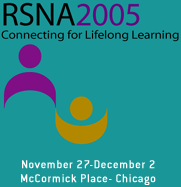
Abstract Archives of the RSNA, 2005
SSC05-04
Assessment of Pulmonary Venous Anatomy during Coronary CT Angiography (CTA)
Scientific Papers
Presented on November 28, 2005
Presented as part of SSC05: Cardiac (Multimodality)
Ethan Joseph Halpern MD, Presenter: Nothing to Disclose
Behzad Pavri MD, Abstract Co-Author: Nothing to Disclose
Left atrium (LA) ablation / pulmonary vein (PV) isolation is gaining acceptance as a treatment for atrial fibrillation. Although there is emerging consensus about ablating outside the pulmonary vein ostia, most centers deliver “spot lesions” at sites demonstrating PV potentials close to the PV ostia. Esophageal injury and esophagoatrial air embolization are recently described complications (J Thorac Cardiovasc Surg 125(4):836-842, 2003). We evaluated PV anatomy during coronary CTA to demonstrate the relationship of the PV’s and the posterior wall of the LA to the esophagus, and to document the frequency of PV anatomical variations.
Coronary CTA was performed with a Brilliance-16 slice scanner (Philips Medical Systems). PV anatomy was evaluated in 80 patients with gated image reconstruction at 1mm thickness. The distance between the esophagus and the junction of each PV with the LA was measured.
A portion of the posterior LA wall was in direct contact with the esophagus in 80/80 subjects. The right superior pulmonary vein (RSPV) was the most anteriorly situated PV with an average distance of 19.5mm to the esophagus (range: 1-49mm). The remaining PVs often joined the LA closer to the esophagus, with an average distance of 10.1mm for the RIPV, 4.1mm for the LSPV, and 5.4mm for the LIPV. At least one PV was in direct contact with the esophagus as it joined the LA in 47/80 subjects. Accessory PVs draining directly into the LA were most commonly from the RML (n=15), but also drained the RLL (n=3), RUL (n=1) and lingula (n=1). A common trunk drained the LSPV and LIPV in 6 subjects. The LSPV was observed to drain into the superior aspect of the LA (above the LA appendage) in 35/80 subjects.
The anatomic relationship between the PVs/LA and the esophagus is clearly demonstrated during coronary CTA. Common variations in PV anatomy include accessory PVs, a common trunk for the LSPV and LIPV and drainage of the LSPV into the superior aspect of the LA. There is sufficient individual anatomic variation that pre-procedural imaging provides valuable information to guide mapping and ablation for atrial fibrillation.
Halpern, E,
Pavri, B,
Assessment of Pulmonary Venous Anatomy during Coronary CT Angiography (CTA). Radiological Society of North America 2005 Scientific Assembly and Annual Meeting, November 27 - December 2, 2005 ,Chicago IL.
http://archive.rsna.org/2005/4405800.html

